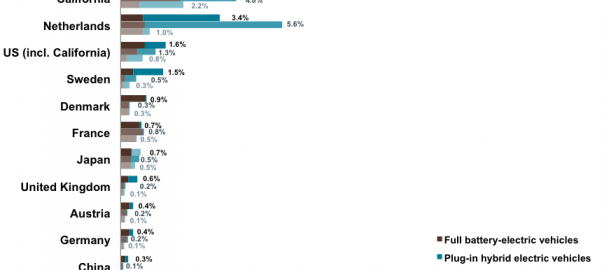Among the biggest stories of 2014 was the crash in global oil prices. Just when it looked like the world had started to take $100/barrel oil for granted, prices plunged by 50 percent. Some speculated that lower oil prices would translate into reduced consumer enthusiasm for electric vehicles (EVs). Now that we have EV sales for 2014 tallied up, let’s look at how the story actually played out.
As it turns out, EVs, including battery electric vehicles (BEVs) and plug-in hybrid electric vehicles (PHEVs), continued to sell consistently around the world. The EV market share in Norway is still far ahead of other countries, at 13.8% of new car sales in 2014. However, in Sweden, the United Kingdom, Denmark, and China the EV market tripled, while in Austria and Germany the EV sales share nearly doubled. The Netherlands is the only country that saw a big drop in EV sales, from 5.6% to 3.4%, likely due to a decline in fiscal incentives. Electric vehicle market share in other countries, including the US, France, and Japan, remained consistent in comparison to 2013.
Further, compared to the first half of 2014, the dramatic drop in global fuel prices during the second half of 2014 did not have any measurable impact on EV sales, and some markets even saw EV sales spike towards the end of the year. There are two main reasons for this: (1) Savings from fuel/electricity costs are only part of all EV incentives, which mainly consist of a variety of fiscal or non-fiscal benefits, and (2) in some countries, particularly in the European Union, fuel taxes already account for a large share of total fuel price, so even during times of fluctuation in global oil price the price at the pump remains relatively stable.

Read more: Business Spectator
